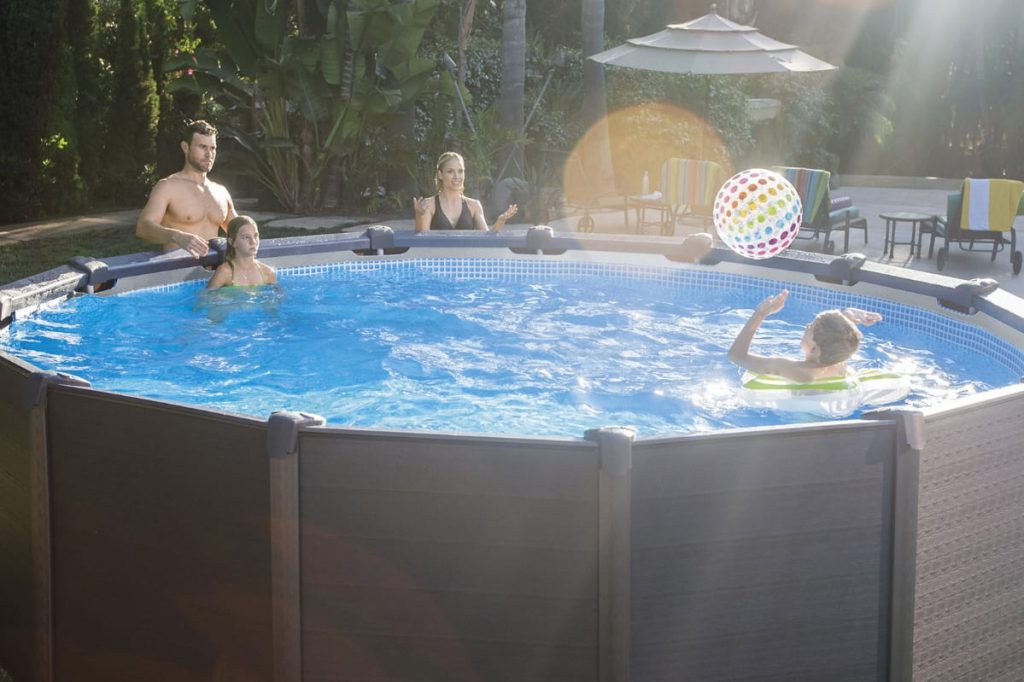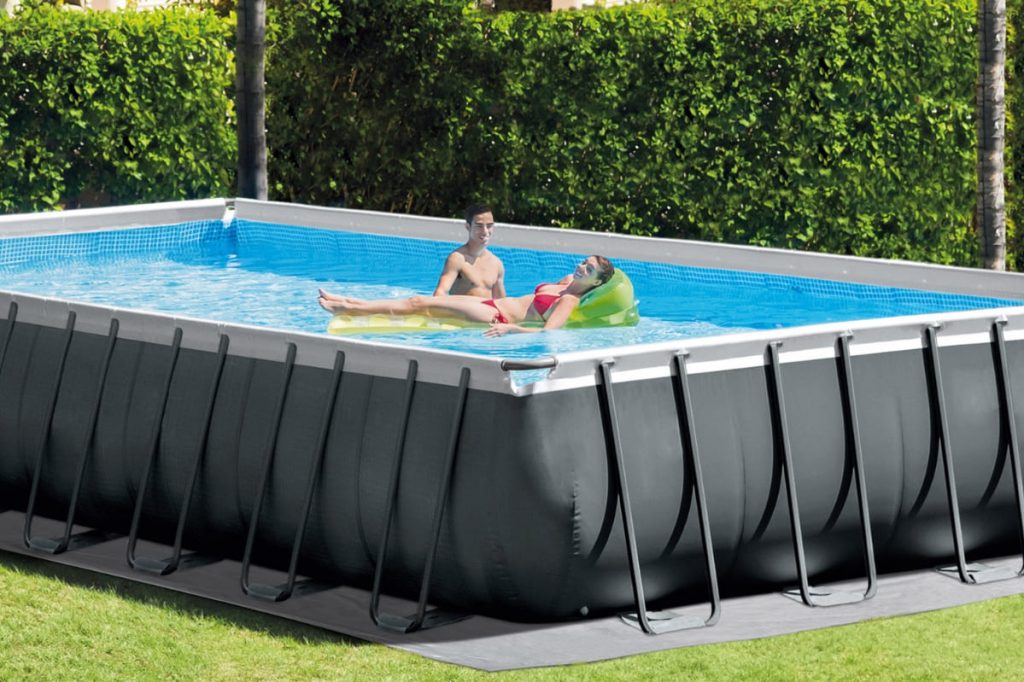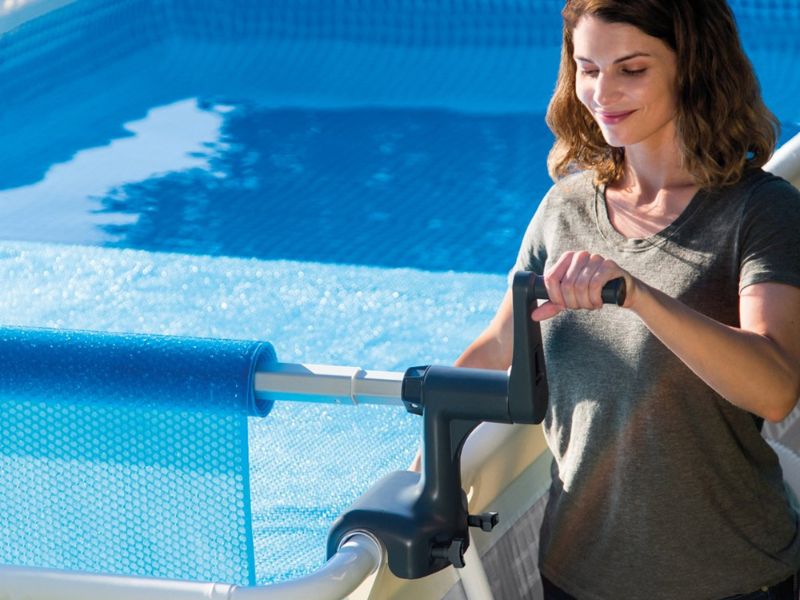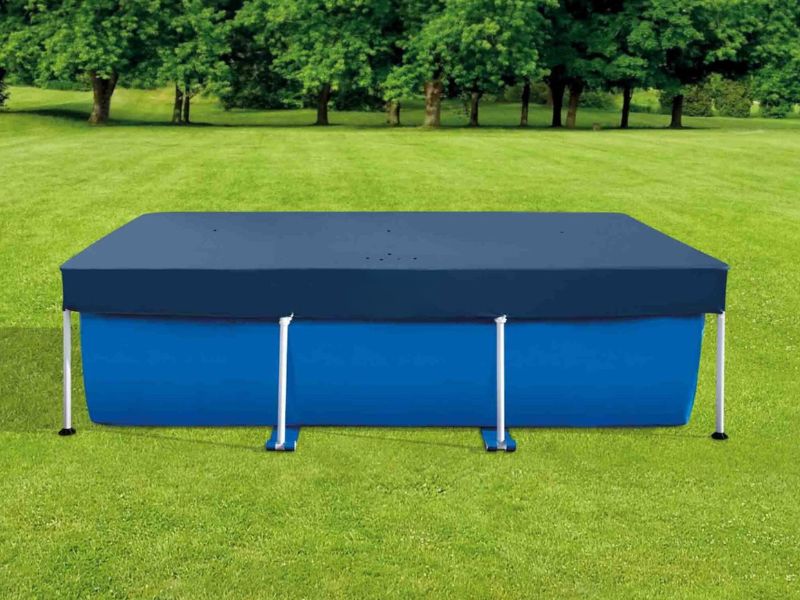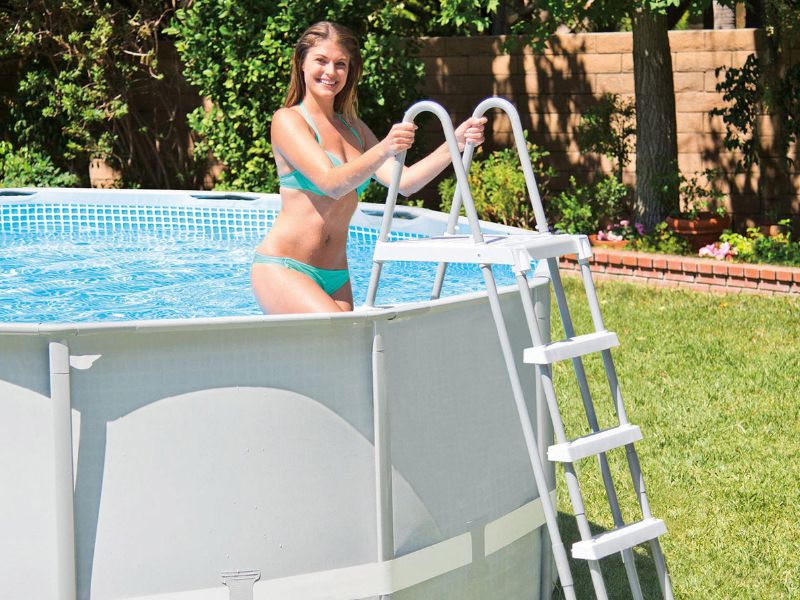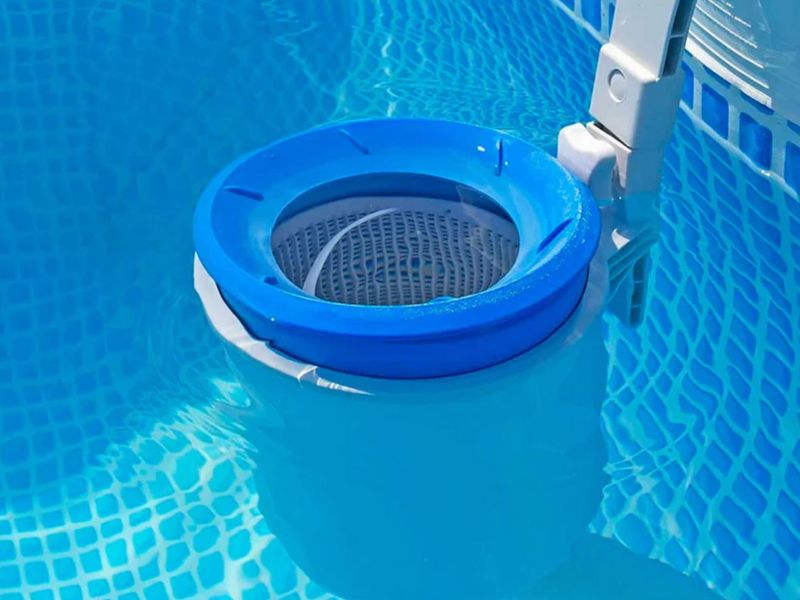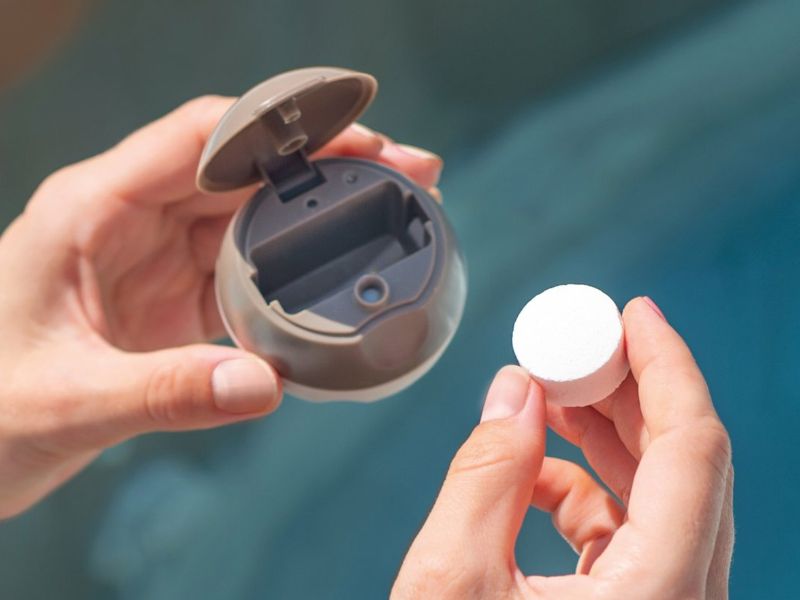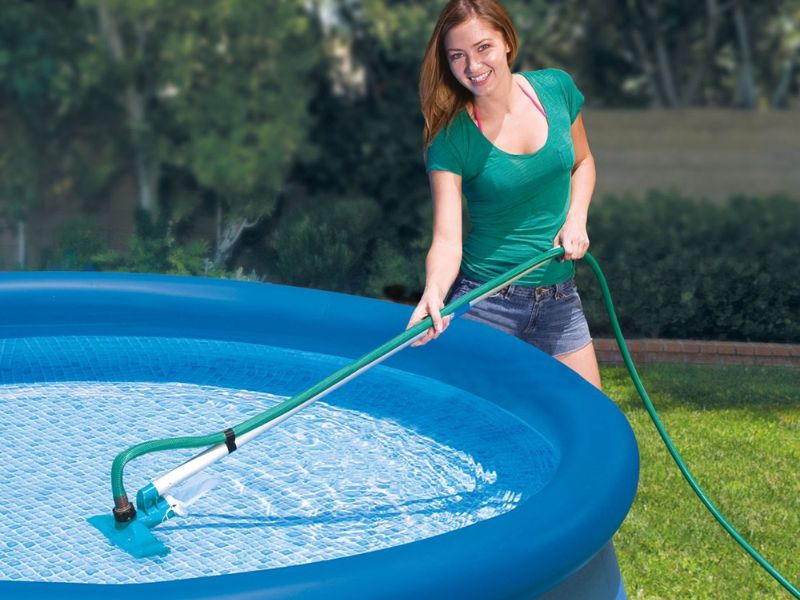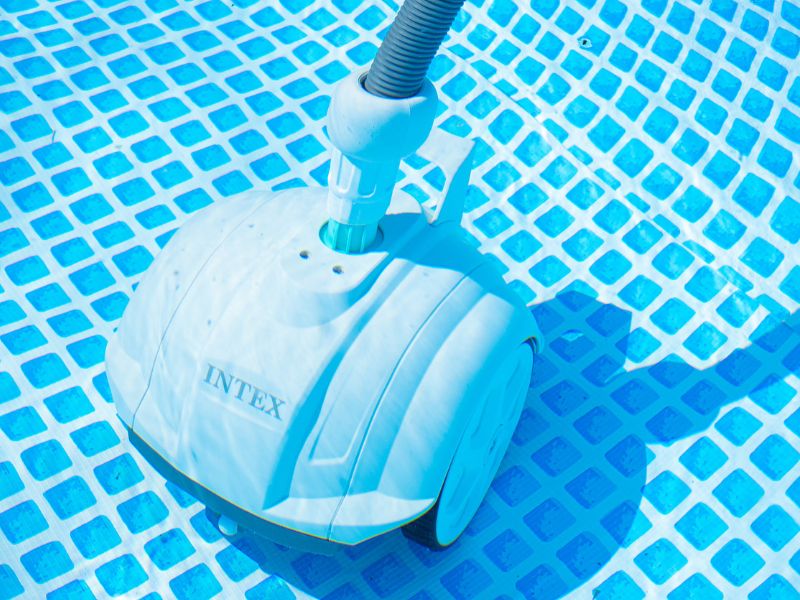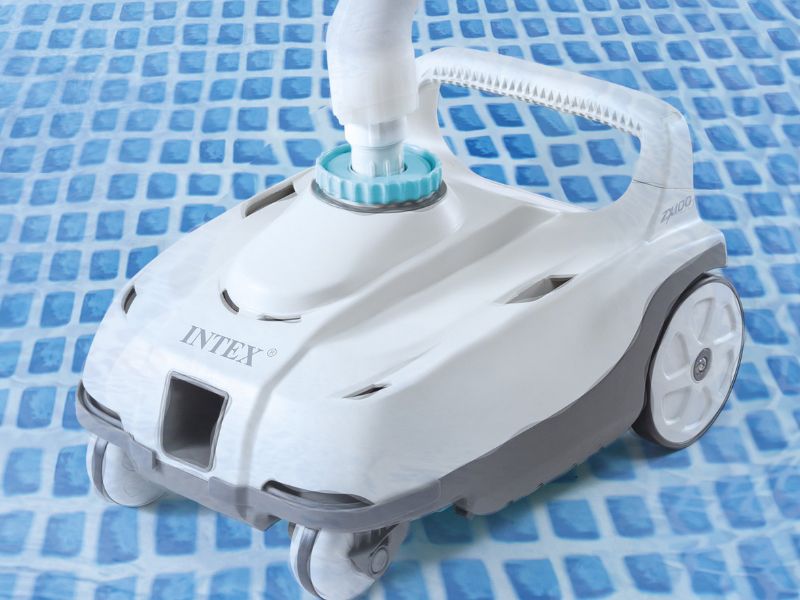A complete guide to purchasing the best above-ground pool with or without a hot tub to place in your garden or balcony, with many useful tips on installation and maintenance.
CONTENTS
- The Complete Guide to choosing the best above-ground pools, edited by our experts
- 1. Above-ground pool: a brief introduction
- 2. Installing and assembling above-ground pools
- 3. How to choose the best above-ground pool? All key factors
- 4. Above-ground pool: rigid, inflatable or tubular?
- 5. Water filtering and pumping system
- 6. Accessories for above-ground pools
- 7. Above-ground pool or inflatable outdoor hot tub?
- 8. Above ground pools and outdoor hot tubs compared: pros, cons, size and price
- 9. Frequently Asked Questions
- 9.1 Questions on the installation and dismantling of above-ground pools
- Can I use sand to level the ground for my above-ground pool?
- Why is it important that the ground is levelled, with no slope and no debris on the surface?
- Why is it important to avoid creases when applying the liner?
- Why is it important to leave the liner in the sun before spreading it?
- Is it always necessary to dismantle the pool at the end of the season? What happens to the water I filled the pool with in case I decide to dismantle it?
- How to dismantle the above-ground pool?
- 9.2 Maintenance questions
- Can grass grow through the base cloth and/or pool liner?
- Can the pump stay on during bathing?
- Why are there algae and greenish water in the pool?
- What to do if the water in the above-ground pool is not clear?
- What should the PH of the water be? How do you measure the chlorine and PH values of water?
- What happens if I use too much or too little chlorine?
- Will using the chlorinator make the pool water salty?
- 9.3 Questions on correct use and safety
- 9.1 Questions on the installation and dismantling of above-ground pools
The Complete Guide to choosing the best above-ground pools, edited by our experts
This purchasing guide on above-ground pools is designed for those looking for a practical and affordable way to cool off during the summer.
In the following paragraphs we will take a closer look at the various aspects of above-ground outdoor pools, starting with their installation, and examine in detail both simple outdoor or garden pools and pools with hot tubs and spas.
We will specifically analyse the different above-ground outdoor pools by examining aspects such as the type of structure, water and people capacity, and water filtration systems. Furthermore, you will learn everything you need to know about maintenance and use toensure that your outdoor pool lasts as long as possible in safety. Ultimately, we also gathered all this information in a convenient summary table.
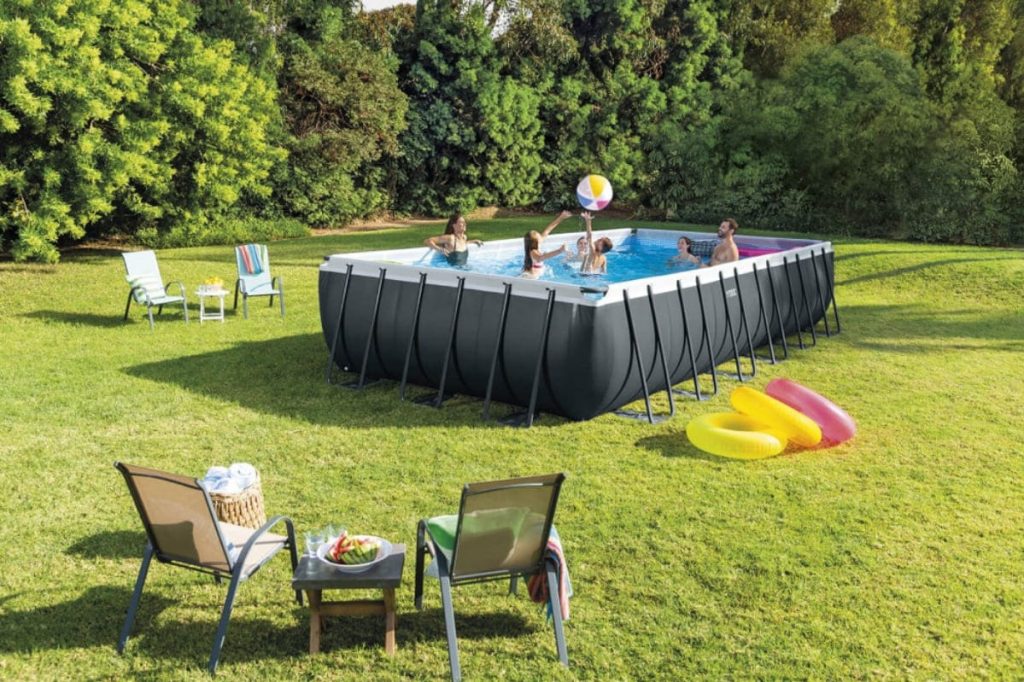
1. Above-ground pool: a brief introduction
Above-ground pools are a practical and convenient solution for those who wish to enjoy the comfort of a swimming pool without the cost and construction work of an in-ground pool. These pools, which can be easily installed in gardens or other outdoor spaces, offer the flexibility to be assembled and disassembled as required.
Above-ground pools usually feature:
- Liner: this is the inner liner that retains water, usually made of PVC or similar materials, and is tear and weather resistant. The best liners consist of three layers, one of reinforced polyester and two of cut-resistant PVC to offer even more resistance to above-ground pools.
- Structure: supports the liner and shapes the pool. It can be made of steel, resin or composite materials, ensuring sturdiness and durability. For inflatable pools, as mentioned below, the liner itself serves as the structure of the above-ground pool.
- Filtration system: keeps water crystal-clear and clear, essential for preserving the aquatic environment. Normally, it is also necessary to use special chemicals to clean the water besides the classic types of filters, which we will elaborate on later.
1.1 Some useful considerations when choosing the best outdoor pool
- When purchasing an above-ground pool, we recommend choosing the material the liner and its structure are made of according to the climate and intended use for maximum durability.
- The installation of an above-ground pool requires adequate space, preferably on flat, smooth and solid surfaces like concrete, to ensure stability and safety. It is essential to ensure that the chosen area is away from trees and structures that could compromise the structure or water quality.

In order to choose the best above-ground pool, however, the above-mentioned aspects, mentioned in a superficial way, are simply not enough. Here are some key issues to consider when choosing an outdoor swimming pool.
2. Installing and assembling above-ground pools
The installation of an above-ground pool, especially if it is a tubular pool, requires attention to detail to ensure its safety and longevity. These pools, in fact, are among the most complex to assemble due to their structure incorporating metal pipes and supports.
As for other types of pools, on the other hand, it is enough to simply place them on the ground, on a suitable and previously prepared surface, fill and/or inflating them depending on the model, and finally, follow the instructions in the manual to connect the various filter systems.
Nonetheless, we will proceed later to describe, in more detail, the individual types of garden or outdoor pools we mentioned so far.
2.1 Key steps for installing a tubular above-ground pool
- Unboxing: when opening the package of the pool you have purchased, avoid using cutting tools such as box cutters to prevent damage to the liner. Also remember to place the liner out in the sun to give it time to warm up, 36 to 48 hours, and soften the various layers of PVC it is made of. This way, any small damage to the PVC that could undermine the stability and strength of your above-ground pool will be avoided.
- Ground preparation: Make sure that the chosen area is perfectly smooth. Use a roller or leveller to checkthe evenness of the soil. Remove stones, roots or any objects that could damage the liner. The choice of an uneven or sloping ground could cause the structure to shift or collapse.
- Positioning the base cloth: The liner must be laid out carefully to protect it from any perforations or abrasions. It is advisable to use an additional cloth, or even better, rubberised tiles under the main cloth for extra protection.
- Assembling the tubes: Make sure that each link is firm and secure, avoiding forcing that could deform or damage the pipes. The only link that will not be firm are those at the corners of the tubulars, although they will be once the pool is full of water and the various tubulars of the structure are in tension.
- Liner installation: When placing the liner inside the structure, avoid dragging or pulling it forcefully. Spread the material evenly to avoid excessive tension that could cause damaging tearing or stretching. Try to hold the liner in place while filling the pool.
- Filling process: Fill the pool slowly, periodically checking the distribution of the liner. This step is crucial to ensure that the liner fits correctly to the shape of the pool without creating creases or gaps.
- Structure inspection:During the filling process, it is essential to monitor the stability of the tubular structure. Adjust the tubes if you notice deflections or buckling. Check that the buttresses are firmly secured and that there is no irregular movement. Repeat this process at least once every hour.
2.2 Useful tips and tricks to simplify installation
- Make sure you have at least two helpers for the installation, as some steps require the coordination of several people.
- When assembling hoses, use baby powder to facilitate their sliding inside the sleeves during assembly and prevent corrosion.
- When filling, check and adjust the liner to avoid creases. We recommend filling the liner with water up to 4-5 centimetres and then spreading it from the inside out by hand. Two people will be needed for this operation: one inside the pool spreading the liner, one outside adjusting and pulling the buttresses.
- Frequently check the stability of the tubulars during the first stages of filling.
- Check the tension of the buttresses so that they work properly. Should you notice that they are ”loose”, pull their base outwards so that they are all in tension.
3. How to choose the best above-ground pool? All key factors
When choosing which above-ground pool to buy there are many factors to take into account, therefore choosing the best outdoor pool can seem rather challenging. However, with the right advice, we are certain that you will find the perfect solution for your outdoor space.
Here are the key factors to consider when choosing:
- Size and capacity: before purchasing an above-ground pool, we advise you to think carefully about where you will install it and thus the space you have available, as well as how many people you think will use it.
- Structure: depending on their structure, we can divide them into:
- Inflatable pools: Easy to assemble and ideal for confined spaces.
- Tubular pool: Robust with a metal support structure.
- Rigid pools: They offer greater durability and are built to last.
- Waterfiltering and pumping system:
- Glass or quartz sand pumps: They offer superior filtration and are suitable for larger pools, though they are more expensive. Sand can be replaced with filtration spheres, which are undoubtedly cheaper and more efficient since 500 g of spheres are equivalent to about 18 kg of sand and are reusable.
- Sand pumps with chlorinator: They integrate filtration and sanitisation.
- Cartridge pumps: Cheap and easy to maintain, they are suitable for moderate-sized pools.
- Type of use: Determine whether you prefer a pool exclusively for swimming or cooling off during the summer or one with hot tub and/or spa functions. Outdoor hot tubs are often heated, so they offer relaxation and therapy through hot water jets and are ideal for muscle relaxation.
Here we examine the aforementioned aspects in more detail.
3.1 Shape, size, capacity, total number of people
Choosing the best above-ground pool also means carefully evaluating the space available and the number of people who will use it. In fact, as we already mentioned, we forewarn you that you will probably have to prepare the space in which to install your outdoor pool specifically to avoid any breakage and damage to the liner or other parts as much as possible.
Assessing the space you have available for your outdoor pool means thinking carefully about the following aspects of the pool:
- Shape: Possible options include round, oval, and rectangular shapes. For those who want a pinch of luxury, octagonal hot tubs are available as well. We advise you to choose the pool according to the shape of the space in which you will install it.
- Size: Variable from small (270x200x60 cm) to large (1000x550x132 cm), suitable for different spaces. The average size of an above-ground pool is roughly as follows: 540x270x132 cm.
- Capacity: These pools can hold 940 L to 54,000 L of water, adapting to different needs. A medium-sized pool usually holds around 16,000 L.
- Number of people: The capacity ranges from 1 to 25 people, allowing both small families and large groups of friends to be accommodated.
4. Above-ground pool: rigid, inflatable or tubular?
Having reached this point, it is necessary to reflect on the type of structure of the pool as this aspect is crucial for both budget and purpose. As we have already anticipated, outdoor pools can be:
- rigid,

- inflatable,

- tubular.

4.1 Rigid above-ground pools: robustness and design
Rigid above-ground pools are the strongest and most durable option as they are, to all intents and purposes, a true semi-permanent pool. Made of galvanised steel or wooden panels, they are extremely weatherproof and stable and can stay in place all year round. Perfect for those looking for elegant design and superior quality product, rigid pools fit perfectly into all outdoor settings.
Why choose a rigid above-ground pool?
- Robustness and durability: ideal for frequent and intensive use
- Wide range of shapes and sizes: to meet all space and taste requirements
- Elegant design: they enhance the garden and create a sophisticated atmosphere
- Easy installation: simply connect the bars to the self-locking connectors and fill with water.
- Included accessories: these pools are usually supplied with sand pump, pool ladder, cover and base cloth, skimmer, chlorine dispenser and repair patch
- No dismantling required: these pools can remain installed all year round, so the water they contain can always be reused without draining.
4.2 Inflatable above-ground pool: practicality and fun
Inflatable outdoor pools are the most affordable and practical solution. They are typically made of high-quality material that combines a polyester core with two layers of PVC to ensure a durable and long-lasting structure.
It only takes a few minutes to inflate them, then they are ready to be used by filling them with water. Let us try to explain this process better. The inflatable part is the upper edge of the pool. Once the edge is inflated, the pool can be filled with water without any problem. The edge will lift itself, acting as a container for the water, as it will be positioned above the waterline in the pool.
Lightweight and compact, inflatable models are ideal for those with confined space or those looking for a temporary solution, perfect for cooling off and having fun with family and friends.
Why choose an inflatable above-ground pool?
- Affordable price: the cheapest choice among above-ground pools
- Quick installation: Simply locate a flat surface, inflate the upper edge and fill the pool with water.
- Minimum maintenance: inflatable pools are usually equipped with cartridge filters that must be replaced every 15 days to ensure effective water filtration.
- Space-saving solution: ideal for small gardens
- Easy transport and storage: perfect for seasonal use
- Safety for children: soft, inflatable edges
- Included accessories: these pools are usually supplied with a cartridge flotation pump, base cloth, pool ladder (depending on the case), and repair patch
Can I use a compressor to inflate my inflatable pool?
It is better not to use the compressor to inflate the pool, especially if it is a very powerful one. Excessive air flow could damage the pool. In other words, we advise you inflate your pool with a specific pool pump, whether manual or electric. This type of pump in fact features a valve that prevents excessive inflation.
4.3 Tubular above-ground pools: the right compromise
Tubular above-ground pools are an ideal compromise between practicality and durability. The structure made of metal or galvanised steel tubes treated with an anti-rust powder paint supports the liner made of 3 layers of PVC, two of which are cut-resistant, guaranteeing good stability and strength
These types of pools are somewhat more difficult to install than the other two types but are perfect for those looking for a competitively priced product.
Why choose a tubular above-ground pool?
- Strength and stability: solid and reliable tubular structure if assembled correctly.
- Wide range of models and sizes: to meet every need
- Optimisable with accessories: pumps, filters, ladders and covers
- Affordable price: accessible to a wide audience
- Included accessories: these pools are usually supplied with a sand pump, pool ladder, cover and base cloth as well as repair patch
- No disassembly required: these pools can remain installed all year round, so the water they contain can always be reused without draining.
5. Water filtering and pumping system
Keeping the water in your above-ground pool clean and crystal clear is essential. Let us point out straight away that garden or outdoor pools usually have only one pump, which also acts as a filter through the stages of:
- inlet, the core of the filtration system. In this phase, the pump sucks water from the pool and sends it to the filter to be cleaned.
- outlet. At this stage, the pump feeds the filtered water back into the pool, thus completing the filtration cycle.
Let us now explore the different filtering options available:
- Glass or quartz sand pumps: These systems offer superior filtration and are ideal for larger pools, albeit more expensive. They use fine sand to retain dirt and debris from the water.
- Sand pumps with chlorinator: They combine filtration and sanitisation. The salt chlorinator, also called ‘salt chlorine generator’, is a device that, through electrolysis, produces pure chlorine to disinfect swimming pool water. This process turns salt into chlorine, eliminating algae and bacteria without irritating eyes, hair and skin. The salt in question is not ordinary table salt, but a non-iodized salt specifically for swimming pools.
- Filtration spheres: A much affordable alternative to sand but just as efficient. The filtration spheres, similar to cotton balls, can be machine-washed and reused. 500 grams of spheres are equivalent to about 18 kg of sand.
- Cartridge pumps: They are the least expensive and easiest to maintain, suitable for moderate-sized pools. These pumps use filter cartridges that capture debris and are easily replaceable.
How many hours a day should the filter pump be kept running?
The sand filter pump should be kept running for 6 to 8 hours every day. Remember to use the 6 functions of the multi-way valve.
What to do if filtration is not working?
- Check for obstructions in the system
- Check that pipes are not twisted or reverse connected
- Make sure that the distance of the hoses from the pool is not excessive
- Check that the pump is of the right power according to the pool
- Check that the pump is not programmed wrongly
6. Accessories for above-ground pools
To get the most fun and safety from your above-ground pool, it is essential to choose the right accessories. Many of these accessories are not included in the standard equipment and differ according to model and cost. Here is an overview of the most common accessories:
- Filter pumps: Essential for keeping water clean, generally included in all but the small inflatable models.
- Repair patch: Useful for quick repairs, usually included to facilitate immediate liner maintenance.
- Cloth for pool base: Necessary to protect the pool floor from scuffing and perforations and therefore of fundamental importance. It is usually included in the larger and more expensive models.
- Roller or pool cover: Very important to keep the water clean when the pool is not being used and thus reduce maintenance. Particularly useful for heated hot tub spas as it speeds up the water heating process. It is generally included in high-end models.
- Swimming pool ladder: Not always necessary, depending on the depth, width and model of the above-ground pool. Often not included in standard and smaller models.
- Skimmer: Helps remove debris from the water surface, only included in more advanced models.
- Chlorine dispenser or chlorinator: Facilitates the even distribution of chlorine thus keeping the pool water clean. Only found in some specific models.
- Cleaning kit: Not always included and with various components depending on the pool purchased.
- Pool cleaning robot: Usually purchased separately, they automatize cleaning ensuring convenience and effectiveness.
We also stress that refills for filtration pumps, especially those with cartridges or balls, non-iodized salt for chlorinators or other water cleaning chemicals must be purchased separately.
7. Above-ground pool or inflatable outdoor hot tub?
If you are considering purchasing a swimming pool for your garden, you may be wondering which between a simple above-ground pool and a outdoor bath tub spa pool is the better option. Both offer great ways to relax and have fun, but hold distinctive features that may influence your decision.
Above-ground pools are excellent solutions for those looking for an easy way to add a pool in the garden without the complexities of building an in-ground pool. They come in various materials such as reinforced PVC, they can be inflatable or made of rigid panels.
On the other hand, the hot tub spa pools offer superior luxury. These pools are in fact equipped with water jets that massage and relax the body. In addition, these pools usually feature a water heating system that can increase the temperature up to 5°C in about 5 hours of operation, with an increase of no more than 1°C per hour, ensuring constant comfort.
A much appreciated feature is the possibility to control the temperature and power of the water jets from a convenient display or through a special App that you can download to your mobile phone.
Some of the main features of above-groundpools with hot tubs are as follows:
- Water heating: allows comfortable use even on cooler days.
- Possibility of remote or touchscreen control: thanks to these systems you can keep the water temperature and the power of the water jets under control at all times.
- Advanced filtration systems: such as sand pumps with chlorinator or cartridge pumps to keep the water clean and crystal-clear at all times.
- Water softening system: The Hard Water and Saltwater systems cooperate to soften the water, preventing limescale build-up and generating chlorine through the salt device.
- Durable materials: built to withstand various elements and last.
Is the SPA pool suitable for terraces?
Yes, if the base on which the spa pool is to be placed is made of reinforced concrete. Whatever the case, we recommend contacting the manufacturer first to find out the capacity of the floor. Specifically, the floor must support the load of the pool filled with water together with the weight of the people in it.
8. Above ground pools and outdoor hot tubs compared: pros, cons, size and price
We have now come to the end of our purchasing guide for the best above-ground pool. We have therefore prepared this table to sum up all the key information on all the different above-ground pools we have mentioned in this detailed article, hoping it will be helpful.
| Pool type | Pros | Cons | Size (longer side or diameter) | Average price |
|---|---|---|---|---|
| Rigid | – Robustness, – durability, – elegant design, – wide range of shapes and sizes, – easy installation, – various accessories included | – Higher cost, – higher maintenance | 3 to 5 metres | 700 € to 1.600 € |
| Inflatable | – Affordable price, – quick installation, – minimal maintenance, – soluzione salvaspazio e di facile stoccaggio, – easy transport, – child safety, | – Less strength and durability, – instability in high winds, – requires a flat, debris-free surface for installation – few accessories included | 2 to 4 metres | 50€ to 200€ |
| Tubular | – Robustness, – easy to install, – good price-quality ratio, – wide range of models and sizes, – optimisable with accessories often included, – affordable price, | – Less sophisticated design, – average installation difficulty, – larger footprint, – requires a flat, debris-free surface for installation | 3 to 10 metres | 500€ to 2.000€ |
| Hot tub spa | – Easy assembly and installation, – combination of powerful jets and/or bubbles, – elegant design, – heated water 10 – 40° C, – rather small in size, – easy maintenance, | – High energy consumption for water heating – Expensive maintenance – Limited size – Limited number of people | 1.8 to 2.2 metres | 700€ to 1.300€ |
9. Frequently Asked Questions
Here is a list of some of the most frequently asked questions from our customers about the installation and dismantling, maintenance, and use of above-ground pools.
9.1 Questions on the installation and dismantling of above-ground pools
Can I use sand to level the ground for my above-ground pool?
We advise you not use sand to level the ground for the pool. Sand, when exposed to high pressures such as those generated by the weight of hundreds of litres of water, tends to deform, thus creating an unstable area. This could lead to subsidence in the pool structure.
Why is it important that the ground is levelled, with no slope and no debris on the surface?
Before answering, it should be pointed out that these factors are especially important for large pools.
A swimming pool filled with water, lying on even gently sloping ground, will undergo a higher pressure on the side that is lower down than on the side that is higher up, caused by the weight of the water inside it. This pressure difference can, over time, lead to deformation of the pool and its structural failure.
Moreover, the ground must not have any debris or pebbles on the surface touching the liner. Again, the pressure that the water will exert on the liner once the pool is full will be so high that, where debris and liner come into contact, small gashes and therefore water leaks may occur.
Why is it important to avoid creases when applying the liner?
Again, you must consider what might happen to the liner when the pool is full of water and when it exerts its pressure on the liner. Pressure could create micro tears on the liner located right on the creases and compromise its strength until it breaks.
Why is it important to leave the liner in the sun before spreading it?
The liner is made of several layers of PVC, each with its own specific characteristics. Since PVC is a plastic material, it can be softened by heat. Spreading the liner after letting it warm up in the sun not only makes it easier to handle, but also avoids causing small damages to the PVC that could compromise the seal of your above-ground pool over time.
Is it always necessary to dismantle the pool at the end of the season? What happens to the water I filled the pool with in case I decide to dismantle it?
It is not absolutely necessary to dismantle the pool at the end of the season; on the contrary, manufacturers of above-ground pools usually advise against it. This means that you will not have to empty the pool and that you can reuse the water in it as long as you treat it properly with the appropriate chemicals and filter and/or clean it of any debris or organic material that may have entered it. In other words:
- not a drop of water will be wasted;
- no waiting for hours before filling your pool again.
How to dismantle the above-ground pool?
To disassemble it, simply reverse the assembly process. We also advise cleaning all components, drying them well if washed, and storing them in a clean place away from moisture. The same applies to liners.
9.2 Maintenance questions
Can grass grow through the base cloth and/or pool liner?
Yes Some types of robust grass (Bermuda or St. Augustine) can grow through the pool liner. Hence, it is recommended to clean the area of these types of hardy grasses before preparing the pool. We also recommend that you use a base cloth or a waterproof cloth to place under the liner to prevent this.
Can the pump stay on during bathing?
It is not mandatory to keep the pump switched off during bathing as all pumps are very safe. However, to avoid even the slightest chance of accidents occurring, especially if you foresee children using the pool, we advise you to turn it off. You can always switch it back on immediately after you have finished bathing.
Why are there algae and greenish water in the pool?
If the water in the pool is greenish, the liner is slippery and/or smelly, and black and green spots are present, it means that the PH level of the water and the amount of chlorine it contains is not correct. You can solve the problem by adding chlorine with anti-algae shock treatment and monitoring the PH of the water more often.

What to do if the water in the above-ground pool is not clear?
- Check the PH level and make sure it is within the recommended range.
- If you have a pool with a sand filter pump, use a Flocculant product by pouring it directly into the pool water.
- Clean the pool and remove any residue.
- Frequently backwash the filter..
What should the PH of the water be? How do you measure the chlorine and PH values of water?
The water PH level must range between 7.2 and 7.6 and the chlorine between 1 and 1.5 ppm. It is possible to measure water quality using different types of testers:
- electronic: the most precise but also the most expensive method.
- tablet: used mainly for testing for free chlorine. It has extended validity and average cost
- drop: this is used to analyse total chlorine and has a validity of less than one year. It is not very accurate for PH. but it is definitely the cheapest method.

What happens if I use too much or too little chlorine?
- Too much chlorine: Wrinkle formation on the liner, appearance of white spots, fading and bleaching on the liner , accelerated ageing of the liner.
- Too little chlorine: poor effectiveness of disinfectants, deterioration of water quality, increased biofilm growth on the liner leading to discolouration.
For even distribution of chlorine in the pool, we recommend using a dispenser. By doing so, among other things, liner discolouration will be avoided.
Will using the chlorinator make the pool water salty?
The chlorinator is a saline chlorine generator. This device will in fact dissolve a certain amount of non-iodized pool-specific salt into the pool water, as needed, to make it slightly salty. The salty water passes through the chlorinator’s electrolytic cell, which will then produce the chlorine needed to destroy bacteria and algae as well as oxidise other organic materials.
9.3 Questions on correct use and safety
Do you need safety and emergency equipment near the pool?
Although it is not mandatory for private households, it is recommended to keep emergency equipment such as first aid kits near the pool area. This equipment helps to prevent accidents or to react quickly if needed.
Can animals play in the above-ground pool?
Although it may be tempting to let pets play in the water, it is not recommended for above-ground pools. Animal nails can damage the liner and compromise water hygiene.

Can you dive into the pool?
It is important to avoid diving into above-ground pools, especially shallow ones such as inflatable or tubular pools. The structure and depth of these pools are not designed to withstand the impact of diving, increasing the risk of injury.




